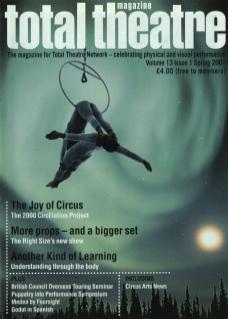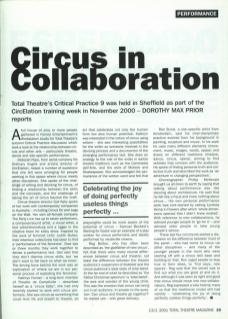A full house of sixty or more people gathered in Forced Entertainment's Workstation studio for Total Theatre's autumn Critical Practice discussion which took a look at the relationship between circus and other arts – particularly theatre, dance and site-specific performance.
Deborah Pope, from aerial company No Ordinary Angels and artistic director of CircElation, raised a number of questions that she felt were emerging for people working in this space where circus meets other disciplines. She spoke of the challenge of writing and devising for circus, of finding a relationship between the skills and the concepts, and the challenge of taking the art of circus beyond the craft.
Circus-theatre director Gail Kelly spoke of her work with contemporary companies in Australia – including Circus Oz and Legs on the Wall. Her own all-female company, The Party Line, has up to seven performers, a composer/sound artist, a visual artist, a text artist/dramaturg and a rigger in the creative team for every show. Inspired by the work of feminist critic Judith Butler, their intention collectively has been to find a 'performance of the feminine'. Over two or three months they work together to devise a performance text. Gail said that they don't dismiss circus skills, but ‘we don't want to fall back on what we know'. The driving force behind the work was an exploration of 'where we are in our personal process of exploding the feminine'.
Kathryn Hunter – a long-term member of Theatre de complicite – described herself as a 'circus baby': she had only recently started to work with circus performers. She saw circus as something that could lend life and breath to theatre, an art that celebrates not only the human form but also human potential. Kathryn was interested in the notion of circus using writers – she saw interesting possibilities for the writer as someone involved in the devising process and a documenter of the emerging performance text. She drew an analogy to the role of the writer in earlier theatre traditions such as the Commedia dell'Arte, and the work of Molière and Shakespeare. She acknowledged the permanence of the written word and felt that playwrights could be more aware of the potential of circus – Samuel Beckett's Waiting for Godot was an example of a play written for circus performers and ideally performed by vaudeville clowns.
Reg Bolton, who has often been described as ‘the godfather of new circus', felt that there were many crucial differences between circus and theatre; not least the difference between the theatre audience's suspension of disbelief and the circus audience's ideal state of total belief. At the far end of what he described as ‘the Father Christmas spectrum’ is 'total belief, the awe and wonder of the young child’. This was the emotion that circus can bring out in an audience. In answer to the question 'Can circus and theatre go together?' he replied yes – with great delicacy.
Ron Bunzl, a site-specific artist from Amsterdam, said his interdisciplinary practice evolved from his background in painting, sculpture and music. In his work he uses many different elements (movement, music, images, words, space) and draws on different traditions (theatre, dance, circus, opera), aiming to find vehicles that connect with the audience. He spoke of finding personal truth and collective truth and described the work as 'an adventure in changing perspectives'.
Choreographer Phillip Mckenzie brought us all down to earth by saying that talking about performance was like dancing about architecture. He said that he felt like a fraud and knew nothing about circus... His own personal performance work was kick-started by seeing Lyndsey Kemp in Flowers after which 'whole dimensions opened that I didn't know existed'. With reference to new collaborations, he advised younger people to go for it – and advised older people to take young people's advice.
These last few comments started a discussion on the difference between most of the panel – who had come to circus via other disciplines – and many of the younger people in the room who were starting off with a circus skill base and building on that. Ron urged people to stay true to their ideas, to ‘find ways, new spaces'. Reg said that the secret was to find out what you are good at and do it. And although it was seen as right and good that circus should move into new collaborations, Reg expressed a view held by many of us that the traditional model still had validity – ‘celebrating the joy of doing perfectly useless things perfectly’.

